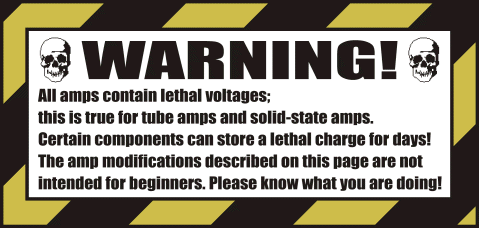Transient fidelity
This mod consists of an attempt to extract the most in
terms of transient fidelity from the YBA-1 signal path without altering the
gain structure or intended dynamics beyond, let's say what one might want
to establish as a typically objectionable point in some kingdom somewhere...
[1a] decoupling input bias circuits, i.e., replace the 820 Ohm/250 uF bias
circuit of the input gain stages by separate 1k5/125 uF and 1k5/0.68uF
cicuits. Cap value varies according to taste, the larger cap will give you
deeper bass response - Traynors seem to sound woofy if a too large cap is
used here...
Some people like to keep the original functionality of the amp intact but
then, in the separated cathode circuit version maybe have a large value on
one side and a lean on the other as in Marshall 1986s and 1959s. I prefer
[1b] disabling the second channel altogether and having a non-electrolytic
0.68uF cap as the only cathode bypass cap in the whole signal chain - the
amp then becomes a pure single channel, high transient fidelity signal path
...this is especially noticeable during periodes of sharp transient attacks... even at low level it'll knock you out...
[2] change 4Meg volume pot(s) to 1MegA for a less "spongy" attack ...
[3] change tone stack to 5F8/6-A values, i.e., 47k to 56k and 0.1uF to
0.02uF. This network impedance matches well with the spectral nature of
many typical guitar pickups... amongst other things it brings in the
midrange dip and narrows the treble and bass peaks closer together...
[4] I like the old presence control, i.e. the old "scratchy" style circuit
with only the 4.7k Pot and cap on the wiper. Sometimes, as an add-on I
like to use a
[5] dual 4.7k pot wired to a DPDT switch (to yield a 2.5k
equivalent pot) in the presence circuit in order to alter loop gain of
output stage feedback mixing at the flick of a switch... this tends to
favorise pentode distortion in the amp and also loosens the output stage a
bit - at lower volume settings this gives a normaly stiff class-AB amp a
slightly livelier feel... I learnt a simpler version of this this from
Dave Vidal in Vancouver who worked for Red Rhoads in LA during the
seventies - the version I explain here is my own...
[6] I like reducing the 100k feedback return resistor to 47k, this tightens
the output stage and balances things out with mod [5]... set to taste.
[7] The power supply B+ filters caps could use a few more Farads, 80/450
caps can become 100/450 and 40/450 caps become 50/450; as long as these
values are not exceeded this won't harm the PT... on the other hand the
preamp filter caps I leave as they are value wise.
You can experiment with the triode/pentode ratio when the amp is
overdriving by altering the preamp voltage headroom. The values R21=4k7
and R32=10k can be changed to 1k, 2k2 repectively... I use 2Watt resistors
for this... you will notice a cleaner and slightly brighter response from
the amp... when cranked the pentodes will fire up earlier and give the amp
a truely warm and sexy feel once
[8] a careful biasing and funetuning of
the output tubes has been done.
I hope this encourages other YBA-1 owners to explore the hidden tone
available in this underated beast... especially those who seek
enhancements that don't alter the original set of dominant expressive
characteristics surrounding the amp... these are my ideas and opinions
only, feel free to add or change things to suit your own taste and needs...
Btw, in the single channel version of this mod the discarded gain stage can
be used, in conjunction with a relay circuit, to give a 2 channel switching
amp that produces a jaw dropping 70's overdrive and compression....






